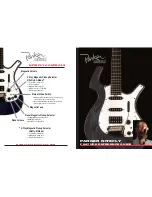
25
25
Using accelerator will speed the process of the CA glue open time to a
matter of seconds.
Note:
Accelerator uses a chemical process that creates intense heat and a
nasty smell that can burn and irritate your nose, eyes and skin. Be sure to
take all the precautions and read the instructions that are on the bottle of the
product you use.
7)
Allow this assembly to dry then lightly sand the abalone inlays until
flush with the fingerboard. Use a 20” radius sanding block,
progressing through the different grits of sandpaper. 80 & 120. You
can use 150, 180 & 220 grits by hand without the radius block as
these are not shaping or aggressive grits. Use the foam sanding pads
and continue to sand to as high grits as you wish. Some builders use
the micro-mesh pads bringing the polishing of the fingerboard through
12,000 grit. This will result in a glass like, silky feel on the
fingerboard.
Note:
Remember, there is NO finish applied to the fingerboard.
8)
Along one edge of the fingerboard there are more holes. Re-drill
following the holes using the .056”/1.4mm to ensure a good fit.
Locate the small white plastic rods included in the kit. Dry fit first!!
9)
Squeeze a small amount of CA glue onto a scrap board and roll the
end of the rod in the glue. Insert the rod until it bottoms out, then cut it
off close to the fingerboard with a utility knife. Continue until all the
holes are filled.









































